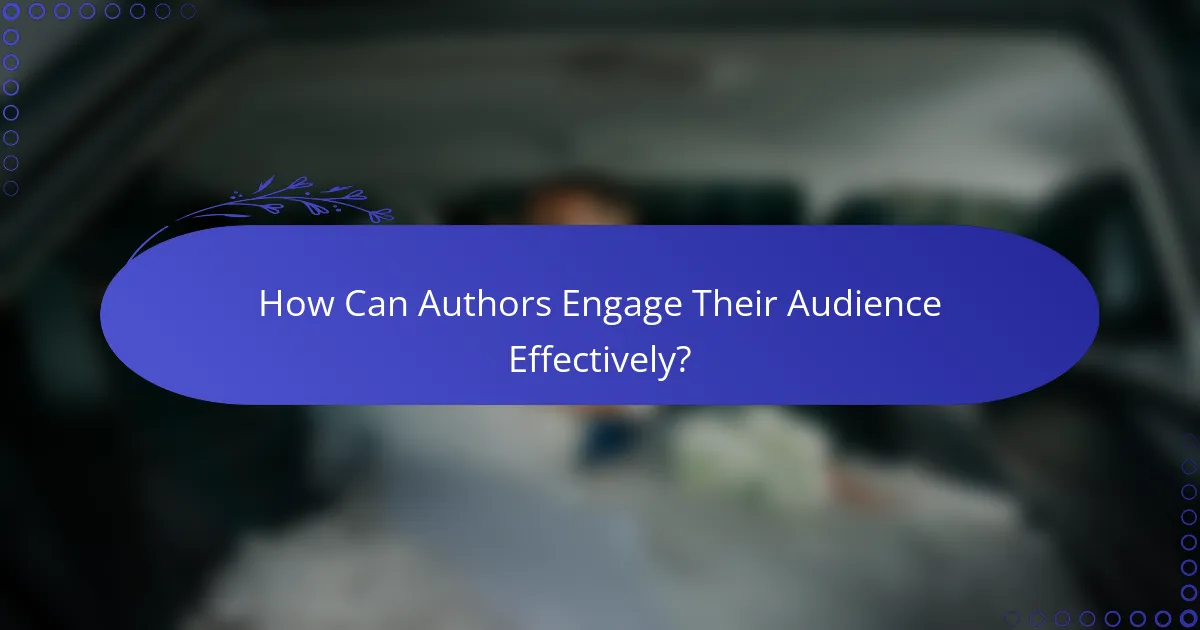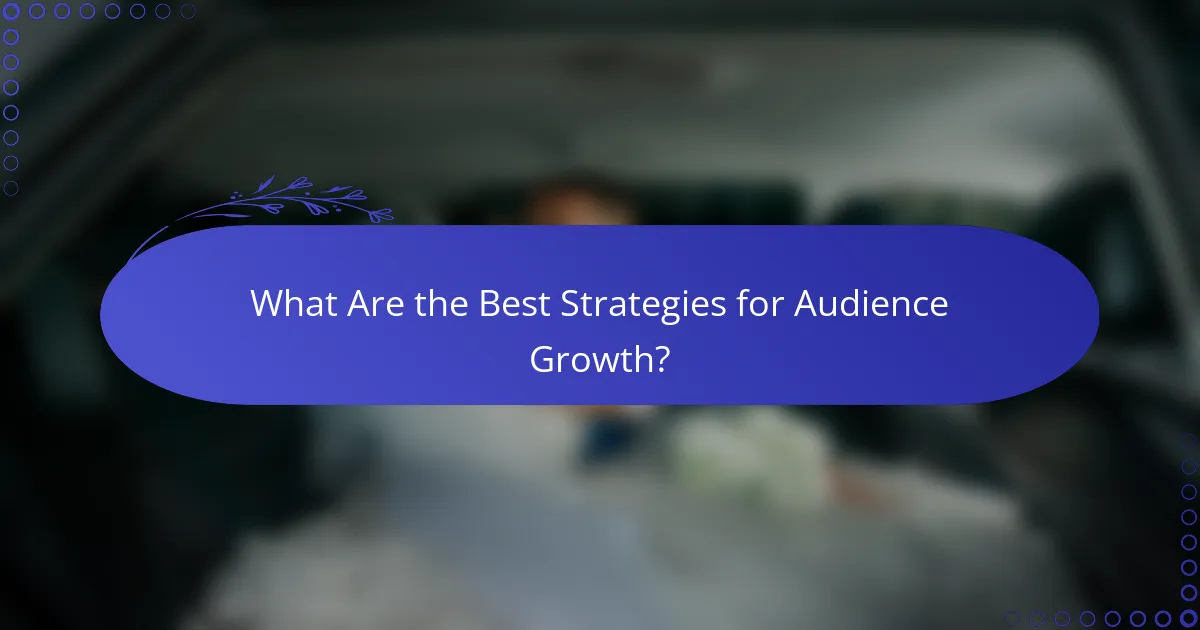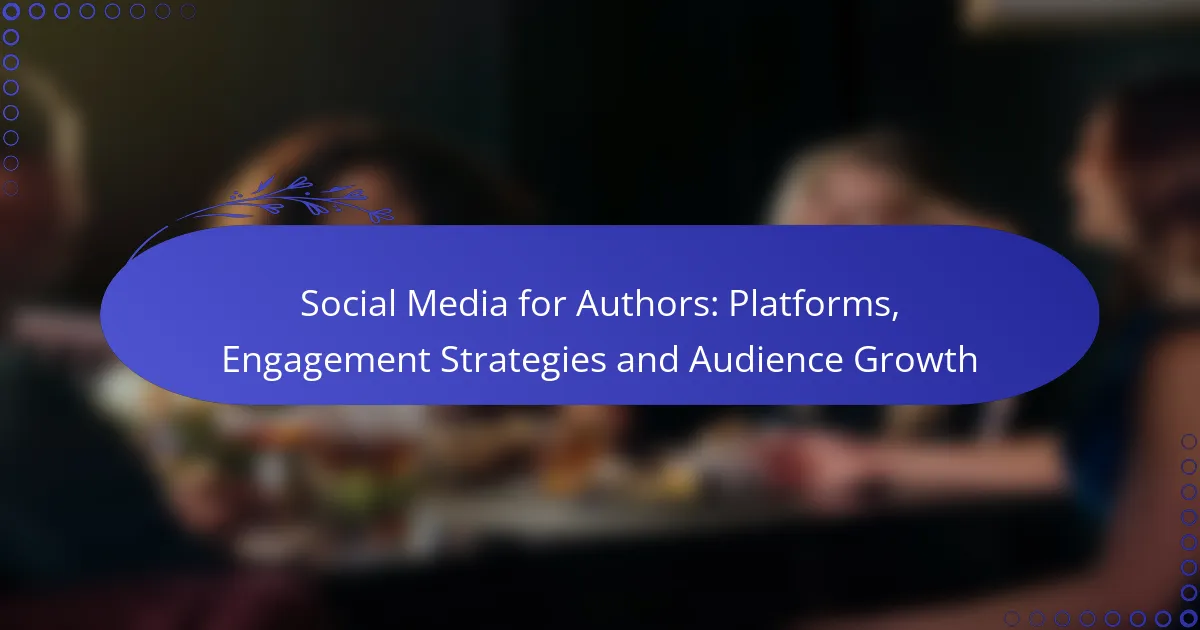Social media offers authors a powerful avenue for engagement and audience growth, with platforms like Facebook, Twitter, Instagram, LinkedIn, and TikTok each providing unique opportunities for connection. By creating interactive and meaningful content, authors can foster deeper relationships with their readers while employing strategies that enhance visibility and encourage participation. Consistent engagement and smart content management are key to effectively expanding reach and connecting with a target audience.

Which Social Media Platforms Are Best for Authors?
Authors can greatly benefit from using social media platforms that cater to their specific needs for engagement and audience growth. The best platforms include Facebook, Twitter, Instagram, LinkedIn, and TikTok, each offering unique features for connecting with readers and promoting work.
Facebook for community building
Facebook is ideal for authors looking to build a community around their work. By creating a dedicated author page or group, writers can engage with fans through posts, events, and discussions, fostering a sense of belonging.
Utilize Facebook Live to host Q&A sessions or book readings, which can enhance interaction. Regularly sharing updates and responding to comments helps maintain engagement and keeps your audience invested in your journey.
Twitter for real-time engagement
Twitter excels in real-time engagement, making it a powerful tool for authors to connect with readers and industry professionals. By participating in trending hashtags or Twitter chats, authors can increase their visibility and join relevant conversations.
Post short updates, share insights, and interact with followers to build relationships. Keep tweets concise and engaging, and consider using visuals to enhance your messages. Aim for consistent posting to stay relevant in the fast-paced environment.
Instagram for visual storytelling
Instagram is perfect for authors who want to showcase their work through visual storytelling. With its emphasis on images and videos, authors can share book covers, behind-the-scenes content, and snippets of their writing process.
Use Instagram Stories and Reels to create engaging short-form content that captures attention. Collaborate with other creators or participate in challenges to expand your reach. Aim for a cohesive aesthetic to attract followers who resonate with your brand.
LinkedIn for professional networking
LinkedIn is essential for authors seeking to establish professional connections within the literary community. It allows authors to share their credentials, publish articles, and connect with industry professionals, including agents and publishers.
Join relevant groups and participate in discussions to showcase your expertise. Regularly update your profile with new publications and achievements to enhance your visibility. Networking on LinkedIn can lead to valuable opportunities and collaborations.
TikTok for creative promotion
TikTok offers a unique platform for authors to promote their work creatively. With its short video format, authors can engage audiences through book trailers, reading excerpts, or fun challenges related to their writing.
Utilize trending sounds and hashtags to increase the chances of your content going viral. Authenticity is key; share personal stories or insights to connect with viewers. Regularly posting content can help build a loyal following and drive interest in your books.

How Can Authors Engage Their Audience Effectively?
Authors can engage their audience effectively by creating interactive and meaningful content that resonates with their readers. This involves using various strategies to foster connection, encourage participation, and enhance visibility across social media platforms.
Utilizing interactive content
Interactive content, such as polls, quizzes, and surveys, invites audience participation and keeps them engaged. For example, an author can create a quiz about their book’s characters or themes, prompting readers to share their results on social media.
Consider using tools like Typeform or Google Forms to create these interactive elements. This not only boosts engagement but also provides valuable insights into reader preferences and interests.
Hosting live Q&A sessions
Live Q&A sessions allow authors to interact directly with their audience, answering questions in real-time. Platforms like Instagram Live or Facebook Live are ideal for this, as they facilitate immediate feedback and foster a sense of community.
To maximize participation, promote the session in advance and encourage followers to submit questions beforehand. This preparation can lead to a more structured and engaging experience for both the author and the audience.
Creating shareable graphics
Shareable graphics, such as quote images or infographics, can help authors reach a wider audience. These visuals should encapsulate key messages or themes from the author’s work, making them easy to share across platforms like Pinterest and Instagram.
Using tools like Canva, authors can design eye-catching graphics that reflect their brand. Ensure the graphics include the author’s name and book title to enhance visibility and recognition.
Running contests and giveaways
Contests and giveaways can significantly boost audience engagement by incentivizing participation. Authors can offer signed copies of their books or exclusive merchandise as prizes, encouraging followers to share the contest with their networks.
To run a successful giveaway, outline clear entry requirements, such as following the author’s page, liking a post, or tagging friends. This not only increases engagement but also expands the author’s reach as more people become aware of their work.

What Are the Best Strategies for Audience Growth?
The best strategies for audience growth on social media involve consistent engagement, collaboration, and smart content management. By implementing a structured approach, authors can effectively expand their reach and connect with their target audience.
Consistent posting schedule
Maintaining a consistent posting schedule is crucial for audience growth. Aim to post regularly, whether it’s daily, a few times a week, or weekly, depending on your capacity and audience preferences. Tools like Buffer or Hootsuite can help you schedule posts in advance.
Consider analyzing your audience’s online activity to determine optimal posting times. Engaging with followers during peak hours can significantly enhance visibility and interaction.
Collaborating with other authors
Collaborating with other authors can broaden your audience and introduce you to new readers. Joint promotions, guest posts, or co-hosting events can create valuable cross-promotion opportunities. Look for authors in similar genres or with complementary themes.
When collaborating, ensure that both parties benefit from the partnership. This could involve sharing each other’s work, co-creating content, or participating in live discussions to engage both audiences.
Using hashtags strategically
Strategic use of hashtags can increase your content’s discoverability. Research popular and relevant hashtags within your genre to reach a wider audience. Aim for a mix of broad and niche hashtags to attract both general and targeted followers.
Limit your hashtag use to about 5-10 per post to avoid overwhelming your audience. Monitor the performance of different hashtags to refine your strategy over time.
Leveraging user-generated content
User-generated content (UGC) can enhance audience engagement and build community. Encourage your readers to share their experiences with your work by tagging you or using a specific hashtag. This not only showcases your book but also fosters a sense of belonging among your audience.
Feature UGC on your profile to highlight reader interactions and create a more personal connection. Consider running contests or giveaways to incentivize readers to share their content related to your work.

What Metrics Should Authors Track on Social Media?
Authors should focus on key metrics like engagement rate and follower growth to assess their social media effectiveness. These metrics provide insights into how well content resonates with audiences and how a following expands over time.
Engagement rate
Engagement rate measures how actively users interact with an author’s content, typically calculated as the sum of likes, comments, shares, and saves divided by total followers. A higher engagement rate indicates that the audience finds the content valuable and relevant.
Authors should aim for an engagement rate of around 1-5%, depending on the platform. For instance, Instagram often sees higher engagement than Twitter, making it crucial to tailor content to each platform’s audience.
To improve engagement, authors can ask questions in their posts, create polls, or share behind-the-scenes content. Avoid posting solely promotional content, as this can lead to lower engagement rates.
Follower growth
Follower growth tracks the increase in an author’s audience over time, reflecting their reach and appeal. This metric is crucial for understanding how well an author is attracting new readers and expanding their brand.
Authors should monitor follower growth on a monthly basis, aiming for a steady increase. A growth rate of 5-10% per month is often considered healthy, but this can vary based on the author’s niche and marketing efforts.
To boost follower growth, authors can collaborate with other creators, participate in relevant hashtags, and engage with their audience through comments and direct messages. Consistency in posting and maintaining a clear brand voice also play significant roles in attracting new followers.
